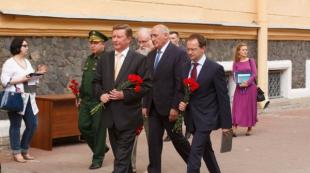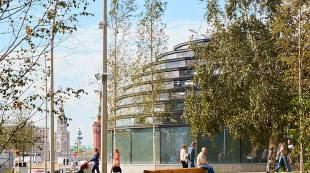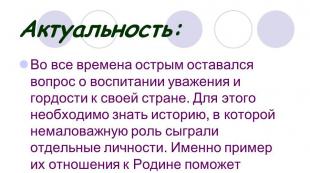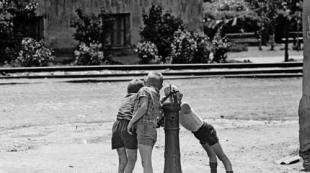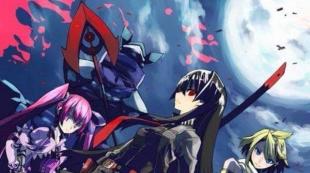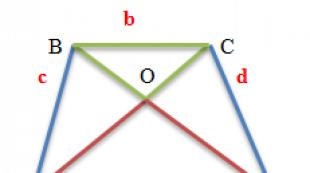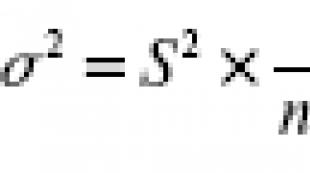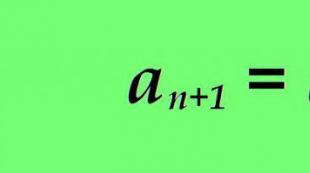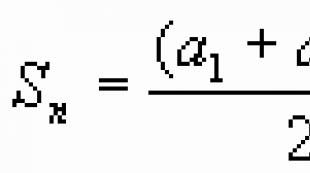Unknown soldier kremlin. The eternal flame in the Alexander Garden. An unknown soldier died here
During the First World War, a grave with a rough wooden cross appeared near the French city of Lille. Nobody knew who was buried here. On the cross was written in plain pencil: "Unknown British Soldier." This grave would have sunk into oblivion if the English chaplain David Railton had not seen it in 1916.
This is how he later described the moment: “How impressed I was by that grave! But who was this soldier, who were his comrades in arms? After all, he could well have been a very young boy? .. I did not have the answer to these questions, I don’t have them even now. And I constantly thought and thought: what can I do to alleviate the grief that befell his father, mother, brother, sister, lover, spouse and friend? The answer came unexpectedly, as if out of a fog, but I was firmly convinced that this was the best answer - "it is necessary with honors to transfer his remains across the sea to his native land." And I realized that this is the happiest moment in my life. "
The remains of the unknown soldier from Lille were never transported home, but the British government appreciated the idea of a monument to a simple unknown soldier. The remains for the memorial were selected very carefully: the creators wanted to be sure that a real English hero who died for his homeland, and not a random person, would lie in the memorial grave. An unknown British regular army soldier was ceremoniously buried at Westminster Abbey on November 11, 1920.
- Tomb of the Unknown British Soldier at Westminster Abbey
- Wikimedia
A similar ceremony took place at the same time in Paris: the French unnamed fighter found peace under the Arc de Triomphe. These two graves became the first monuments to unknown soldiers.

- Tomb of an unknown French soldier under the Arc de Triomphe
- Wikimedia
It was no accident that the idea of this kind of memorials appeared during the First World War. Of course, in the battles of previous centuries there were many unknown dead soldiers, but in the Great (as it was then called) war, the phenomenon of namelessness reached frightening proportions.
The initiative of Great Britain and France was picked up all over the world: the graves of the unknown soldier appeared in Western Europe and Australia, Brazil and Indonesia, Zimbabwe and Iraq, Israel and Peru - the memory of hundreds of thousands of unknown heroes united the whole world. In the Soviet Union, such a monument appeared only in 1967.
No man is an island
The creation of a memorial to the unknown soldier in the USSR was discussed 20 years after the end of the Great Patriotic War- in 1965, after Moscow was awarded the title of Hero City. In fact, the monument received the right to exist by the forces of one person - the first secretary of the Moscow city party committee, Nikolai Grigorievich Yegorychev.

- Wikimedia
The government approved the idea of a national memorial, only Leonid Ilyich Brezhnev was against it: according to one version, he was afraid that the creation of the Tomb of the Unknown Soldier would raise Yegorychev's authority. Nikolai Grigorievich insisted that the monument should be installed under the ancient Kremlin walls, Brezhnev categorically objected to him. Another, probably at this stage, would have abandoned his idea, but Egorychev turned out to be very stubborn. He was ready to start construction on his own. Still, such significant works required the consent of the Politburo, which the head of Moscow eventually received.
The soldier, by tradition, was chosen carefully. It was at that time that a large mass grave was found in Zelenograd during a large-scale construction project. From there, they removed the remains of an unknown soldier in a well-preserved form, but without the officer's insignia.
Yegorychev himself explained the choice as follows: “If it were a shot deserter, his belt would be removed. He could not have been wounded, taken prisoner, because the Germans did not reach that place. So it was quite clear that this was a Soviet soldier who died heroically defending Moscow. No documents were found in his grave with him - the ashes of this private were truly nameless. "
With military honors
The ceremonial funeral of the Unknown Soldier took place on December 3, 1966. The coffin, entwined with an orange and black ribbon, was placed on a combat carriage and taken from Kryukovo station to the Kremlin, accompanied by a guard of honor and a military band. On the final stretch of the journey, he was accompanied by prominent members of the party and General Rokossovsky. The remains of the Unknown Soldier were solemnly buried under an artillery salvo.

- Burial ceremony for the remains of the Unknown Soldier, who died in the battle near Moscow, at the Kremlin wall in Moscow.
- RIA News
The memorial was opened on the eve of Victory Day. On the morning of May 8, 1967, a solemn procession arrived in the capital from Leningrad. A crowd of Muscovites met an unusual load - a torch with an Eternal Flame. He was taken in an armored personnel carrier from the Field of Mars to the Alexander Garden.
The eternal flame at the Tomb of the Unknown Soldier was lit by Brezhnev, having accepted the torch from the hands of the Hero of the Soviet Union Alexei Maresyev. So the secretary general opened the architectural ensemble.

- Wikimedia
The monument is a tombstone covered with a bronze battle banner, on which lie a soldier's helmet and a laurel branch. The eternal flame of glory burns in the center of the memorial, next to it is the inscription: "Your name is unknown, your feat is immortal."
In addition to the grave, the memorial includes a granite alley with dark red porphyry curbstones, each with the name of the hero-city and an engraved image of the Gold Star medal. The pedestals contain capsules with earth from the hero cities. The ensemble also includes a red granite stele in memory of the cities of military glory.

- Wikimedia
Post number 1
Since December 12, 1997, in accordance with the Decree of the President of Russia, post No. 1 of the guard of honor was moved from the Lenin Mausoleum to the Tomb of the Unknown Soldier. The guard is carried out by the military personnel of the Presidential Regiment.

- globallookpress.com
- Dmitry Golubovich
Each city that suffered in the Great Patriotic War keeps the memory of its nameless heroes. The glory of the Unknown Soldier spread throughout the country in hundreds of songs and poems, in commemorative plaques and memorials. Poetess Rimma Kazakova dedicated the following lines to unknown heroes:
They covered up life with themselves,
Those who barely began to live
So that the sky is blue
There was green grass.
- (MATROSA) a symbolic monument in honor of the soldiers who died in the battles. First built in Paris (1921); in Moscow in the Alexander Garden near the Kremlin wall in May 1967 (architects D.I.Burdin, V.A.Klimov, Yu. R. Rabaev; sculptor N.V. Tomsky) ... Big Encyclopedic Dictionary
GRAVE, s, g. Explanatory dictionary Ozhegova. S.I. Ozhegov, N.Yu. Shvedova. 1949 1992 ... Ozhegov's Explanatory Dictionary
GRAVE OF UNKNOWN SOLDIER, symbolic monument in honor of soldiers who died in battle. First built in Paris (1921). In Moscow, a memorial in the Alexander Garden at the Kremlin wall (opened in May 1967; architects D.I.Burdin, V.A.Klimov, Yu.R. ... ... Russian history
- (MATROSA), a symbolic monument in honor of the soldiers who died in the battles. First built in Paris (1921); in Moscow in the Alexander Garden near the Kremlin wall in May 1967 (architects D.I.Burdin, V.A.Klimov, Yu. R. Rabaev; sculptor N.V. Tomsky) ... encyclopedic Dictionary
Memorial architectural ensemble Tomb of the Unknown Soldier Tombstone and Eternal Flame Country ... Wikipedia
Near the Kremlin wall, in, a memorial in memory of Soviet soldiers who died on the fronts of the Great Patriotic War. The remains of the Unknown Soldier, who died in 1941 and was buried in a mass grave at 41 m km, were buried at the wall in December 1966 (25 ... ... Moscow (encyclopedia)
Unkown soldiers grave- Unkown soldiers grave … Russian spelling dictionary
Unkown soldiers grave - … Spelling dictionary of the Russian language
Tomb of the Unknown Soldier at the Kremlin Wall- The Tomb of the Unknown Soldier is a symbolic monument in honor of the soldiers who died in the battles. The first Tomb of the Unknown Soldier was erected in Paris in memory of the victims of the First World War. The ceremony of its opening and lighting of the Eternal Flame took place on November 11, 1920 ... ... Encyclopedia of Newsmakers
Books
- Stalin. We remember together, Starikov Nikolai Viktorovich. In the modern history of Russia, there are no more famous person than Joseph Stalin. The controversy around him does not cease, and the assessments of his activities are diametrically opposed. There is no politician who would ...
- Stalin. We remember together, Nikolay Starikov. In modern Russian history, there is no more famous person than Joseph Stalin. The controversy around him does not cease, and the assessments of his activities are diametrically opposed. There is no politician who would ...
Every year on May 9, Muscovites go to the Eternal Flame to bow to the Tomb of the Unknown Soldier. However, few people already remember the people who created this memorial. The eternal flame has been burning for 46 years. It seems that he has always been. However, the story of its ignition is extremely dramatic. She had her own tears and tragedies.
In December 1966, Moscow was preparing to solemnly celebrate the 25th anniversary of the defense of Moscow. At that time, Nikolai Egorychev was the first secretary of the Moscow City Party Committee. A man who played a significant role in politics, including in the dramatic situation of the removal of Khrushchev and the election of Brezhnev to the post of general secretary, one of the communist reformers.
The anniversary of the victory over the Nazis began to be celebrated especially solemnly only in 1965, when Moscow was awarded the title of a hero city and on May 9 officially became a day off. Actually, then the idea was born to create a monument to ordinary soldiers who died for Moscow. This could only be a monument to the Unknown Soldier.
At the beginning of 1966, Alexei Nikolaevich Kosygin called Nikolai Yegorychev and said: "I was recently in Poland, laid a wreath at the Tomb of the Unknown Soldier. Why is there no such monument in Moscow?"
Brezhnev did not immediately approve of the idea of the monument: “I don’t like the Alexander Garden. Look for another place.”
Egorychev insisted on the Alexander Garden, near the ancient Kremlin wall. Then it was an unkempt place, with a stunted lawn,
The wall itself required restoration. But the biggest obstacle lay elsewhere. Almost at the very place where the Eternal Flame is now burning, there was an obelisk erected in 1913 for the 300th anniversary of the House of Romanov. After the revolution, the names of the reigning house were scraped off from the obelisk and the names of the titans of the revolution were knocked out. The list was allegedly compiled by Lenin personally. Egorychev suggested that the architects, without asking anyone for the highest permission (because they would not be allowed), quietly move the obelisk slightly to the right, where the grotto is. And no one will notice anything. The funny thing is that Yegorychev was right. Had they begun to coordinate the issue of transferring Lenin's monument with the Politburo, the matter would have dragged on for years.
The last most important question is where to find the remains of a soldier? At that time, large construction was underway in Zelenograd, and there, during excavation work, a mass grave, lost since the war, was found. As a result, the choice fell on the remains of a warrior, on whom the military uniform was well preserved, but on which there were no commander insignia. It was quite clear that this was a Soviet soldier who died heroically defending Moscow. No documents were found in his grave with him - the ashes of this private was truly nameless. "
The military has developed a ceremonial burial ritual. From Zelenograd, the ashes were delivered to the capital on a gun carriage. On December 6, from early morning, hundreds of thousands of Muscovites stood all over Gorky Street. People cried as the funeral cortege moved by. Many old women made the sign of the cross over the coffin. In mournful silence, the procession reached Manezhnaya Square. The last meters of the coffin were carried by Marshal Rokossovsky and prominent members of the party.
On May 7, 1967, a torch was lit from the Eternal Flame on the Field of Mars in Leningrad, which was delivered to Moscow by relay. They say that there was a living corridor all the way from Leningrad to Moscow - people wanted to see what was sacred to them. In the early morning of May 8, the motorcade reached Moscow. The streets were also packed with people. At Manezhnaya Square, the torch was received by the Hero of the Soviet Union, the legendary pilot Alexei Maresyev. Unique newsreels have survived, capturing this moment. People froze, trying not to miss the most important moment - the lighting of the Eternal Flame.
The memorial was opened by Nikolai Egorychev.
Almost all the people involved in the creation of this monument had the feeling that this was the main business of their life and that it was FOREVER, FOREVER.
Since then, every year on May 9, people come to the Eternal Flame. Almost everyone knows that he will read the lines engraved on a marble slab: "Your name is unknown, your deed is immortal." But it never occurs to anyone that these lines had an author. And it all happened like that. When the Central Committee approved the creation of the Eternal Flame, Yegorychev asked the then literary generals - Sergei Mikhalkov, Konstantin Simonov, Sergei Narovchatov and Sergei Smirnov - to come up with an inscription on the grave. We stopped at this text "His name is unknown, his feat is immortal." Under these words, all the writers put their signatures ... and left.
Egorychev was left alone. Something in the final version did not suit him: “I thought,” he recalled, “how people will approach the grave. Maybe those who have lost their loved ones and do not know where they found peace. What will they say?
Probably: "Thank you, soldier! Your feat is immortal!" Although it was late in the evening, Yegorychev called Mikhalkov: "The word" his "should be replaced with" yours. "
Mikhalkov thought: "Yes," he said, "this is better." This is how the words engraved in stone appeared on the granite slab: "Your name is unknown, your feat is immortal" ...
It would be great if we no longer had to compose new inscriptions over the new graves of unknown soldiers. Although this, of course, is a utopia. One of the greats said: "Time is changing - but our attitude to our Victories does not change." Indeed, we will disappear, our children and great-grandchildren will leave, and the Eternal Flame will burn.
It seems that the monument to the Unknown Soldier has always been near the walls of the Kremlin. Who will now remember what happened at the site of the memorial, at the place where people silently stop and remember who they owe their lives to? Who will now remember how the eternal flame ended up in the Alexander Garden? On the Day of the Unknown Soldier, we publish facts from the history of the creation of the memorial.
It was decided to create a memorial of national importance - a monument to the Unknown Soldier - for the 25th anniversary of the defeat of German troops near Moscow.
At one time, Brezhnev did not approve of the installation of a memorial in the Alexander Garden. Indeed, at this place there was already a monument with a long history - a monument to revolutionary thinkers and leaders of the struggle for the liberation of the working people. In 1918, at the initiative of Lenin, an obelisk in honor of the 300th anniversary of the Romanov dynasty was converted into it.

It was difficult to decide who exactly to bury at the walls of the Kremlin. The choice fell on the remains of a soldier from a mass grave, just discovered in those days near Moscow. The uniform without insignia and with a belt confirmed that the soldier was not a deserter. A soldier could not be a prisoner either, since the Germans did not reach this place. No documents were found with the soldier, which means that his ashes were really "unknown".
Memorial complex "Shtyki" near Zelenograd - a mass grave from which the ashes of an unknown soldier were transferred for burial in Moscow
On December 2, 1966, the remains of a soldier were placed in a coffin entwined with an orange and black ribbon. And the next day, at 11:45 a.m., the coffin was installed on an open car, which moved along the Leningradskoye Highway to the Aleksandrovsky Garden.

That morning, the entire Gorky Street (now Tverskaya), along which the motorcade was moving to Manezhnaya Square, was filled with people. On December 3, 1966, under an artillery salvo, the ashes of the Unknown Soldier were solemnly buried.

Memorial Tomb of the Unknown Soldier was opened a year later - on May 8, 1967. The monument is a tombstone covered with a bronze battle banner. On the banner are a soldier's helmet and a laurel branch, also made of bronze. The eternal flame of glory burns in the center of the memorial.

Unkown soldiers grave, 1976... Photo: my_journal_omsk
The eternal flame was delivered by armored personnel carrier from the war memorial on the Field of Mars in Leningrad. Leonid Brezhnev lit it at the Tomb of the Unknown Soldier, having accepted the torch from the hands of the Hero of the Soviet Union Alexei Maresyev.

Eternal flame on the Champ de Mars. Photo: Dean Jackson
Next to the fire is the inscription: "Your name is unknown, your feat is immortal."
He was buried in a globe of the earth,
And he was only a soldier
In total, friends, a simple soldier,
No titles or awards.
The earth is like a mausoleum to him -
For a million centuries
And the Milky Way is dusty
Around him from the sides.
The clouds are sleeping on the red slopes,
Snowstorms sweep
Heavy thunder thunders
The winds take a run.
Long ago, the battle was over ...
By the hands of all friends
The guy is put in the globe,
As if in a mausoleum ...
This poem was written by the front-line poet Sergei Orlov in June 1944, many years before the tomb of the Unknown Soldier appeared in Moscow. However, the poet was able to express main essence and the meaning of what has become one of the greatest shrines of our Fatherland, personifying the memory of those who fell on the way to Victory.
Military trick of Nikolai Egorychev
The idea of the tomb of the Unknown Soldier first appeared in France after the end of the First World War, where they decided to honor the memory of all the fallen heroes of the Fatherland. In the Soviet Union, a similar idea appeared 20 years after the Great Patriotic War, when May 9 was declared a day off, and state celebrations in honor of Victory Day became regular.
In December 1966, Moscow was preparing to celebrate the 25th anniversary of the battle under the walls of the capital. At the first secretary of the Moscow City Party Committee Nikolay Egorychev the idea of creating a monument to ordinary soldiers who died in the battle for Moscow came up. Gradually, the head of the capital came to the conclusion that the monument should be dedicated not only to the heroes of the battle for Moscow, but also to all those who fell during the Great Patriotic War.
It was then that Yegorychev remembered the grave of the Unknown Soldier in Paris. While he was thinking about the possibility of creating an analogue of this memorial in Moscow, the head of the government, Alexei Kosygin, turned to him. As it turned out, Kosygin was worried about the same question. He asked: why is there such a memorial in Poland, but not in the USSR?
Tomb of the Unknown Soldier in Paris. Photo: Commons.wikimedia.org
Enlisting support Kosygin, Yegorychev turned to the specialists who created the first sketches of the monument.
The final "go-ahead" was to be given by the leader of the country, Leonid Brezhnev... However, he did not like the initial project. He considered that the Alexander Garden was not suitable for such a memorial, and suggested finding another place.
The problem was also that where the Eternal Flame is now located, there was an obelisk dedicated to the 300th anniversary of the House of Romanovs, which later became a monument to revolutionary thinkers. To carry out the project, the obelisk had to be moved.
Egorychev turned out to be a resolute man - he carried out the transfer of the obelisk with his own power. Then, seeing that Brezhnev did not make a decision on the grave of the Unknown Soldier, he went to a tactical maneuver. Before the ceremonial meeting in the Kremlin on November 6, 1966, dedicated to the anniversary October revolution, he placed all the sketches and models of the monument in the rest room of the Politburo members. When the members of the Politburo got acquainted with the project and approved it, Yegorychev actually put Brezhnev in a position where he could no longer refuse to give the “go-ahead”. As a result, the project of the Moscow tomb of the Unknown Soldier was approved.
The hero was found near Zelenograd
But there was still one more important question - where to look for the remains of a soldier who was forever to become the Unknown Soldier?
Fate decided everything for Egorychev. At this moment, during construction in Zelenograd near Moscow, workers stumbled upon a mass grave of soldiers who died in the battles near Moscow.

The transfer of the ashes of the Unknown Soldier, Moscow December 3, 1966. Photographer Boris Vdovenko, Commons.wikimedia.org
The requirements were strict, excluding any possibility of chance. The grave, chosen in order to take the ashes from it, was located in a place where the Germans did not reach, which means that the soldiers did not exactly die in captivity. One of the fighters has a well-preserved uniform with the insignia of a private - the Unknown Soldier was supposed to be a simple fighter. Another subtle point - the deceased was not supposed to be a deserter or a person who committed another military crime and was shot for it. But the belt was removed from the criminal before the execution, and the belt on the soldier from the grave near Zelenograd was in place.
The chosen soldier had no documents and nothing to indicate his identity - he fell like an unknown hero. Now he was becoming an Unknown Soldier for the whole large country.
On December 2, 1966, at 2.30 p.m., the remains of a soldier were placed in a coffin, at which a military guard was displayed, which was replaced every two hours. On December 3, at 11:45 am, the coffin was placed on a gun carriage, after which the procession headed to Moscow.
On the last journey of the Unknown Soldier, thousands of Muscovites were seen off, lined up along the streets along which the procession was moving.
A funeral meeting was held on Manezhnaya Square, after which party leaders and Marshal Rokossovsky carried the coffin in their arms to the burial place. Under artillery volleys The unknown soldier found peace in the Alexander Garden.
One for all
The architectural ensemble "Tomb of the Unknown Soldier", created by the architects Dmitry Burdin, Vladimir Klimov, Yuri Rabaev and sculptor Nikolay Tomsky, was opened on May 8, 1967. The author of the famous epitaph "Your name is unknown, your feat is immortal" was the poet Sergey Mikhalkov.
On the day of the opening of the memorial, a fire lit in Leningrad from the memorial on the Field of Mars was delivered to Moscow in an armored personnel carrier. He took over the solemn mourning torch relay, which he handed over to the head of the USSR Leonid Brezhnev... The Soviet General Secretary, himself a war veteran, lit the Eternal Flame at the Tomb of the Unknown Soldier.
On December 12, 1997, by the decree of the President of Russia, the post of the guard of honor number 1 was established at the tomb of the Unknown Soldier.
The eternal flame at the tomb of the Unknown Soldier was extinguished only once, in 2009, when the memorial was being reconstructed. At this time, the Eternal Flame was transferred to Poklonnaya Hill, to the Museum of the Great Patriotic War. On February 23, 2010, after the completion of the reconstruction, the Eternal Flame returned to its rightful place.
An unknown soldier will never acquire a first and last name. For all those whose loved ones fell on the fronts of the Great Patriotic War, for all those who did not know where their brothers, fathers, grandfathers laid their heads, the Unknown Soldier will forever remain the same dear person who sacrificed his life for the future of his descendants, for the future of their homeland.
He gave his life, he lost his name, but became dear to everyone who lives and will live in our vast country.
Your name is unknown, your feat is immortal.

